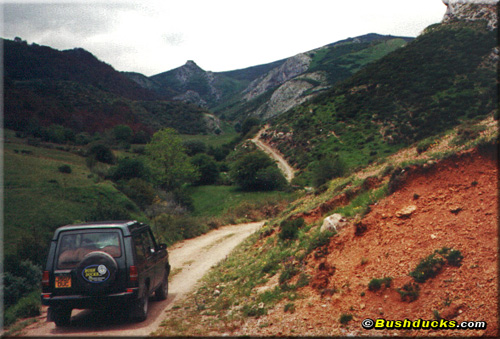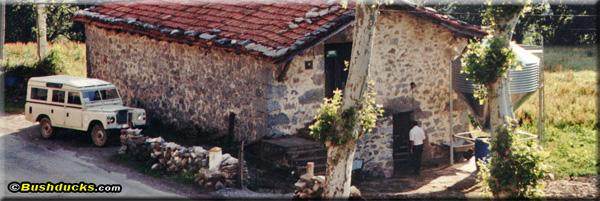|
Our planned four weeks is well over, but what's the hurry? We loop our way slowly
though southern Spain. Camps are always easy to find. Whilst there are few National
Parks in Spain, there is a wealth of land whose ownership is unclear. I suspect that
most of it is government owned and leased to shepherds and farmers. With a little
discretion, it is possible to bushcamp almost anywhere. Pine forests, dehesa,
mountain valleys, cow pastures and the ubiquitous cotos de cazas all made good camps.
The only time we see other campers is in recognised campgrounds attached to towns.
We meet plenty of locals and they play a major part in our happy memories of Spain.
For much of the time we camp in sheep or goat country. Herds of animals with bells
roam the hillsides accompanied by a solitary shepherd and his dogs.
 Often we make camp in an idyllic spot, deserted or so it seems. Invariably about one hour later, we hear the sound of bells getting closer and closer and then along comes a couple of hundred sheep and goats, followed by a solitary, quiet shepherd. Invariably, the shepherd stands quietly looking at us until we notice him and shout "hola!", at which point he comes over, chats, accepts a glass of wine, occasionally share our meal and tell us about the area. Invariably he says we can camp as long as we wanted - expressing surprise that anyone would want to be here in the first place. One great night in the Spanish Pyrenees, we follow a track up to a ruined deserted village. We are looking for somewhere to camp and the flat grassy field next to the village is perfect with a fantastic view over the mountains. We have passed the shepherd and his sheep on the way up, so we drive back to him to ask if it is okay to camp. He is this old bloke, about seventy, tanned and weather-beaten and wearing only a pair of off-white Y fronts, the crotch of which hangs nearly to his knees - the sort of baggy pants that everyone's father wears and no-one wants their boyfriend to wear. He shows us a better place to camp, one that the shepherds use, complete with better view and a table. His dogs are with him, big shaggy mongrels, that he tells us are good dogs. The last ones weren't so good. When he went home one night, they killed a couple of dozen sheep and the remaining sheep panicked and stampeded into a corner, smothering to death. He lost about two hundred sheep, which would be most of a year's income for him. Anyway, off he goes back to the village, leaving us alone, leaving his sheep penned up nearby and his dogs on guard. No sooner do his taillights disappear around the bend, then the dogs take off! Lolloping over the hillside straight for us, hoping for food. We shoo them away and they spend all night rampaging around the hillside, and barking at some unfortunate creature they have bailed up a tree. I don't think they spare a passing look at the sheep they are meant to be guarding! Don't think they are as good dogs as the shepherd thinks.
Tapas, local cheese, jamón serrano, strong coffee in the early morning, dropping into small villages and seeking out the café for breakfast. Eating breakfast at the cafes with the labourers on their way to work in the fields, having their black coffee and brandy with sweet biscuits at 7am. The days drift past, a mix of stone, dust, sheep, coffee and local wine. Drover attracts his share of curious looks. In one small village we pull up outside the bar, and can't help but notice the pile of people at the window, staring at us. We enter the bar, and they scuttle away from the window, embarrassed at having been caught. In conversation at the bar, one young man tells me they have never seen a right hand drive vehicle before.
In the south of Spain we have to watch out for the Toros Bravos - literally "brave bulls", the black fighting bulls of southern Spain. They are turned loose to roam the hillsides until it is time to be rounded up for the bullring. Bred to be fierce, aggressive and fearless, they pose a very real threat for unwary campers. We only see them at a distance, but have to turn back on a few tracks in the mountains when they end abruptly at a 12 foot high wire fence and locked gate, often signed "Animales Peligrosos" (Dangerous Animals).
 The mountains of southern Spain are wonderful, jagged peaks that rear up to the sky, with many small tracks for Drover to explore. The towns and villages are wonderful too - Albaracin, set high on a hillside, fortified with dry stone walls built in the 16th century. La Alberca, a deliberately preserved streetscape of high, narrow adobe buildings, complete with a "tourist pig". One of the big, black pigs that end their days as jamón serrano is wandering around town soliciting food handouts and being photographed by the tourists. The other wandering personality was the local policeman, squeezing through the narrow streets in his Nissan Patrol. Near Zaragosa, we come across a different hermita. The hermita of the Virgen is set hundreds of feet up on a cliff face, the shrine is built in a horizontal crack in the cliff. To reach it, you have to first walk through a bar, also set in the cliff face, then around a precarious walkway before entering the church. A room at the back is covered with evidence of the Virgin's miracles and prayers answered. Wooden legs, wedding dresses, christening shawls, notes asking the Virgin to keep a loved one safe during the compulsory period of military service, photos of family members, flowers, articles of clothing - they are all on the wall, often six deep.
Away from the coast is the Spain most travellers never see. The landscape is red,
dry, dusty and parched. The agriculture is mainly olive groves or almonds. Rows and
rows of the hardy tree stretch in stone-terraced rows, often as far as the eye can
see. But the land is poor and in Extramadura - the poorest area of Spain there is
ample evidence of people having to just uproot themselves from their land and their
houses because the land cannot support them. One sign offers land, planted with
almond trees for sale - converted to Australian Dollars it is 15c a square metre.
The villages here rarely see outsiders, so Drover and ourselves are even more of a
novelty.
 Finally we cross back into France through duty-free Andorra (diesel 50c/litre compared to $1.35 in UK and about $1 in Spain). We enter Andorra the back way, up a small jeep track and over a pass, so there are no officials. Leaving into France we are surprised to be stopped by customs who rattle something incomprehensible in French. Seeing our total look of bewilderment, he says "Alcohol, Tobacco?" and when we still look completely dumb he waves us on and we drive away with all the Spanish gin bottles chinking merrily away in the back. Back in France we spend another week with Jane, who has moved into a Charanteuse farmhouse. Magnificent thunderstorms up though France and then back into Portsmouth on the ferry again. Drover by this time resembles a travelling cellar, as we stock up on French wine and cheese to add to the bottles of Spanish wine stashed in the back. Everytime we pull out clean underwear, a bottle of wine falls at our feet. So we are back. Reluctantly. Do we want to go back? You betcha!
© Bushducks 1997
Be informed when this site is updated: |